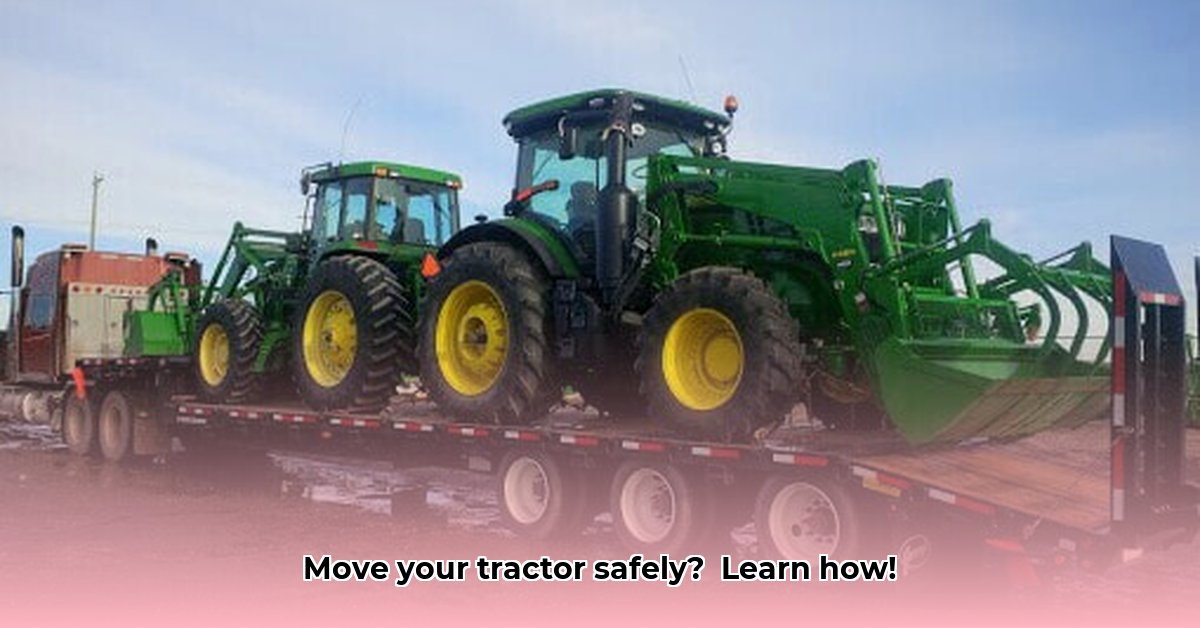
Moving a tractor requires careful planning and execution. This guide provides step-by-step instructions to ensure a safe and efficient transport process, minimizing environmental impact for sustainable farming practices. For more detailed information, see our comprehensive guide on tractor shipping.
Planning & Preparation: Laying the Groundwork
Before moving your tractor, thorough planning is crucial. This includes assessing your tractor's size and weight, obtaining necessary permits, and selecting the appropriate transport method. Failing to plan adequately can lead to delays, fines, and even accidents.
Measure & Weigh: Accurately determine your tractor's dimensions (length, width, height) and weight. This information is vital for selecting the right trailer and obtaining any required permits. (Use a certified scale for accurate weight measurement.) Did you know that incorrect weight estimations can lead to penalties of up to $5000?
Permitting: Research and obtain any necessary permits for oversized or overweight loads. Regulations vary by location; contacting your local Department of Transportation is crucial. Ignoring this step can result in significant fines and delays.
Trailer Selection: Choose a trailer appropriate for your tractor's size and weight. Options include flatbed, lowboy, and removable gooseneck trailers (RGNs). Consider factors like the tractor's ground clearance (high-clearance tractors may need a lowboy). "Selecting the right trailer is 90% of the battle," says John Miller, Transportation Specialist at AgriLogistics Inc.
Route Planning: Plan your route, considering factors such as bridge clearances, weight limits, and road conditions. An efficient route minimizes fuel consumption and reduces your environmental impact.
Securing the Tractor: Safety First
Properly securing your tractor is paramount to prevent accidents and damage during transport. Incorrect securing can lead to serious injury or significant equipment loss.
Pre-Transport Inspection: Perform a thorough inspection of your tractor, addressing any loose parts or potential hazards. This simple step can prevent costly repairs later.
Tie-Down Points: Identify secure tie-down points on both the tractor and the trailer. Avoid using weak points on the tractor's frame. Use a minimum of four tie-down points for optimal stability.
Secure with Chains or Straps: Utilize high-quality chains or straps rated well above your tractor's weight. Secure the tractor evenly, avoiding excessive tension to prevent damage. (Always consult the manufacturer's specifications for recommended tie-down procedures).
Final Check: Before you begin transport, perform a final, comprehensive inspection, ensuring everything is secure. An extra check can save you from potential problems.
Choosing a Transporter: Selecting a Reliable Partner
Selecting the right transporter is vital. Choose a reputable company experienced in moving agricultural equipment.
Reputation Check: Research potential transportation companies, reviewing online testimonials and checking their licensing and insurance. A company with a strong reputation reduces the risk of problems.
Obtain Quotes: Request quotes from several transporters to compare pricing and services. Don’t solely base your decision on price – consider experience and safety records.
Insurance & Licensing: Ensure the transporter has adequate insurance coverage to protect your tractor against damage or loss during transport. Verify their licensing and compliance with all regulations.
The Transportation Process: From Pickup to Delivery
Maintain open communication with your chosen transporter throughout the process.
Schedule: Clearly schedule the pickup and delivery times. Confirm the dates and times with your transporter to avoid any confusion.
Communication: Maintain open communication with your transporter during transit. Regular updates help ensure the smooth progress of your shipment.
Documentation: Maintain detailed records of the entire process, including communication, inspection reports, and any potential issues. Proper documentation aids in addressing any problems that may arise.
Post-Transportation: Inspection and Maintenance
Upon delivery, immediately inspect your tractor for any damage. Document any issues with photos or video.
Inspection: Thoroughly inspect your tractor for signs of damage, noting any scratches, dents, or malfunctioning components. Early detection aids in timely repairs.
Documentation: Thoroughly document any damage discovered, including photos and descriptions, to safeguard your interests. This is crucial for potential insurance claims.
Maintenance: Perform routine maintenance after transport, addressing any issues promptly. This ensures your tractor's continued functionality and efficiency.
Sustainable Practices: Minimizing Environmental Impact
Sustainable practices extend to tractor transport. Consider the environmental impacts of your choices.
Route Optimization: Choose the shortest, most direct route to reduce fuel consumption and emissions. Employ GPS tools to optimize routes and track fuel efficiency.
Eco-Friendly Transporter: Favor transporters committed to sustainability, utilizing fuel-efficient vehicles or alternative fuel sources. This benefits the environment and supports responsible business practices.
Regular Maintenance: Maintain your tractor to optimize fuel efficiency and reduce emissions. Good maintenance translates to lower fuel costs and a smaller carbon footprint.
This guide provides a framework for safely and efficiently transporting your tractor. Always prioritize safety and comply with all applicable regulations. Remember, careful planning and attention to detail are essential for a successful and sustainable transport operation.